The Visionary Behind Burj Khalifa's Design
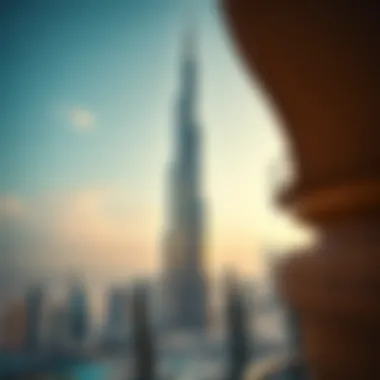
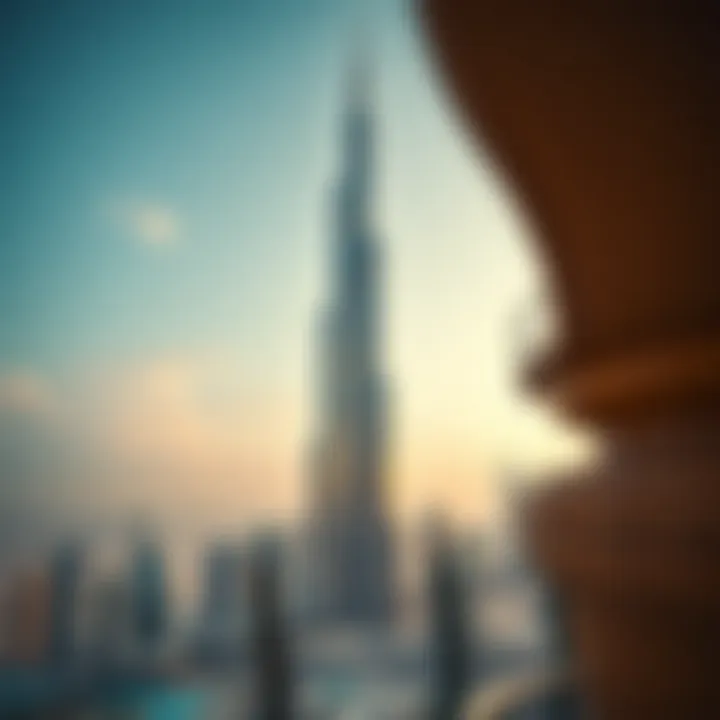
Intro
In the ever-evolving panorama of global architechture, the Burj Khalifa stands out not just for its towering height but also for the audacious vision that sparked its creation. At the heart of this marvel is Adrian Smith, the architect whose concept entwined with Dubai's aspirations to reshape its skyline. Burj Khalifa is more than a mere structure; it acts as a canvas reflecting the ambitions of a city that catapulted onto the world's radar in a matter of decades. Smith's work has left undeniable footprints, weaving intricate patterns into the realm of design and engineering.
The interplay of luxurious aesthetics and functionality, coupled with Dubai’s rapid growth, creates a compelling narrative worth exploring. Understanding the mind behind Burj Khalifa allows one to appreciate not only the architect's brilliance but also the cultural backdrop against which this edifice flourished. This article navigates through the inception, design, and the challenges that accompanied the construction of one of the pinnacles of modern engineering, serving to unravel layers within the building that go beyond mere concrete and steel.
Market Insights
Current Trends in Dubai Real Estate
Dubai's real estate market is currently characterized by a unique blend of opportunities and challenges. The skyline, dominated by structures like Burj Khalifa, reveals the ambitions of property development. With the city positioning itself as a global hub, demand for high-end residential and commercial properties remains remarkably high. Recent trends have shown an increase in interest from foreign investors, largely driven by attractive residency incentives and a robust tourism sector.
Furthermore, the Covid-19 pandemic, while initially causing disruption, has prompted a reshaping of the market landscape. People now favor spacious living environments as they seek comfort and serenity. This shift has manifested in the rising popularity of villas over compact apartments, and people are drawn to community-centric developments that promote a balanced lifestyle.
Future Predictions and Market Analysis
Looking ahead, the forecast for Dubai’s real estate sector appears optimistic. Analysts predict sustained growth driven by factors such as the continual influx of expats and tourists. Moreover, upcoming events like Expo 2025 and other international exhibitions are set to bolster investor confidence.
A strategic focus on sustainability is also transforming project developments. Properties that emphasize energy efficiency and environmental responsibility are likely to capture attention, ensuring they are aligned with global standards.
"The Burj Khalifa doesn’t just scrape the sky; it reflects Dubai’s ethos of reaching for greatness."
Adrian Smith’s architectural ingenuity behind the Burj Khalifa serves as an emblem of the ambitions that shape the very core of this city, pushing boundaries and redefining possibilities in the realm of architecture and real estate. As the skyline of Dubai continues to evolve, so too does the potential for investment, presenting opportunities for those who are willing to adapt.
Investment Opportunities
High-ROI Property Areas
When considering investments in Dubai, certain areas stand out based on their potential for high returns. The downtown district, where Burj Khalifa resides, remains a prime location due to its luxurious appeal and proximity to large-scale amenities. Yet, other locales, such as Dubai Marina and Palm Jumeirah, also offer lucrative options, particularly for those targeting the high-end rental market.
Identifying areas with upcoming infrastructure projects often signals future value increases. Communities that focus on mixed-use developments with added lifestyle offerings frequently attract a higher caliber of renters and buyers.
Tips for First-Time Investors
For those venturing into Dubai’s real estate market for the first time, several strategies can enhance the likelihood of success:
- Research Extensively: Understand market trends, average pricing, and location advantages.
- Consult Local Experts: Real estate agents or property managers familiar with Dubai’s nuances can provide invaluable guidance.
- Evaluate the Market Cycle: Timing plays a crucial role; assessing whether it's a buyer's or seller's market can guide your decisions.
- Consider Long-Term Investment: Focusing on properties that promise sustained growth can yield better returns.
By aligning these insights with the architectural marvels like Burj Khalifa, investors can navigate Dubai’s dynamic landscape more effectively, allowing them to not only partake in the vibrancy of this metropolis but also reap the benefits of its meteoric growth.
Intro to Burj Khalifa
The Burj Khalifa stands as a towering monument, not just in terms of height but also in its significance to the city of Dubai and the world at large. To understand why this grand structure matters, we must first consider the transformative journey of Dubai itself—a city that has evolved dramatically from a modest fishing village to a global metropolis. The Burj Khalifa, completed in 2010, not only symbolizes Dubai's aspirations but also serves as a testament to human ingenuity in architecture and engineering.
Located in the heart of Downtown Dubai, the skyscraper reaches an astonishing 828 meters. This towering structure has become synonymous with Dubai’s skyline, drawing millions of visitors who marvel at its height and design. More than just a high-rise building, Burj Khalifa is an icon that embodies the ambitions of a nation striving for prominence on the world stage. With its stunning architecture by Adrian Smith, it blends traditional Islamic design with modern aesthetics—remarkable in every sense.
Historical Context
Before the Burj Khalifa could rise to the heavens, we must take a step back and look at the historical context surrounding its inception. The early 2000s marked a period of rapid growth for Dubai, driven by economic diversification away from oil reliance. The government aimed to position Dubai as a leading tourist destination and business hub, which ultimately led to the bold decision to construct the world’s tallest building.
- Economic Shifts: The 1990s laid the groundwork through investments in infrastructure, such as the Dubai Metro and various free trade zones that drew foreign investments.
- Urban Vision: Sheikh Mohammed bin Rashid Al Maktoum, the ruler of Dubai, visualized a city that integrated luxury living with business and leisure. The Burj Khalifa was designed to be a centerpiece of the city's ambitions, nestled among malls, parks, and hotels.
Initial Conceptualization
The journey of Burj Khalifa began with a vision to create not just a building, but a landmark. In the early stages, the initial concept was to construct a mixed-use skyscraper that would house residential, office, and hotel spaces. Adrian Smith, at that time an architect in the firm Skidmore, Owings & Merrill, was approached to lead the design team, bringing a blend of artistic vision and architectural expertise.
- Design Inspiration: The design evolved with inspiration from Islamic architecture, particularly the traditional minaret. The tapering structure is influenced by the Hymenocallis flower, a feature that symbolizes the integration of nature and architecture, paying homage to the local environment.
- Challenges & Adjustments: The team had to navigate through technical challenges and city regulations, all while ensuring that the building could be successfully constructed to handle Dubai's extreme weather conditions—especially the high winds at such elevations.
As the Burj Khalifa started taking shape, it became clear that it represented more than steel and glass; it was a beacon of ambition, exemplifying modern engineering and architectural prowess, a perfect blend of necessity and artistry.
The Visionary Architect
In delving into the world of architectural grandeur, the role of the architect cannot be understated. When we talk about Burj Khalifa, the tallest structure globally, it is impossible to overlook the creative mind of Adrian Smith. His influence not only shaped the physical form of the building but also captured the spirit of a rapidly modernizing Dubai. This section explores the profile of Adrian Smith and his distinctive design philosophy, highlighting how his vision transformed the skyline and redefined architectural standards.


Profile of Adrian Smith
Adrian Smith, born in Chicago in 1944, has become a name synonymous with innovative skyscraper design. Graduating from the University of Illinois at Urbana-Champaign with a Bachelor of Architecture, he joined the prestigious architectural firm Skidmore, Owings & Merrill. During his long tenure, he participated in several high-profile projects, notably the Burj Khalifa, where he took the lead as the design partner. His experience reflects a unique blend of creativity and technical knowledge—a combination that significantly contributes to his success as an architect.
Smith’s work is characterized by a keen understanding of urban dynamics and sustainability. He possesses an ability to integrate environmental considerations into structures without compromising aesthetic appeal. This thoughtfulness is manifest in how Burj Khalifa interacts with its surroundings, embracing local culture while pushing architectural boundaries.
"The tallest buildings often convey the aspirations of a city. Burj Khalifa is no exception; it embodies Dubai's ambitions on a global scale."
Not just a figure in the background, Smith has also published various articles and contributed to talks about architecture, emphasizing innovation and environmental stewardship. His perspective often leads to a discussion about not just how buildings look but how they function and affect the lives of those around them.
Design Philosophy
Adrian Smith’s design philosophy for Burj Khalifa is a testament to his understanding of architecture as a dynamic interaction rather than a static representation. Rather than strictly adhering to conventional forms, Smith opted for a spiraling design that references the geometries of local motifs and traditional Islamic features.
- Cultural Context: Smith aimed to ensure that Burj Khalifa celebrates Dubai’s heritage while signifying its modern ambitions. The tower's three-lobed footprint reflects traditional Islamic architecture, while the upward thrust subtly mimics the desert flower, Hymenocallis, unique to the region.
- Sustainable Practices: Smith's dedication to sustainability is reflected throughout his design choices. He incorporated features aimed at maximizing energy efficiency, such as a double-glazed facade that reduces heat gain, and the strategic placement of shaded terraces.
- Human-centric Approach: A key consideration in Smith’s philosophy is to enhance the human experience within the spaces created. The Burj Khalifa is not merely an observation tower but a mixed-use structure that includes residential, corporate, and recreational spaces, designed thoughtfully to cater to its diverse set of occupants.
Through his design philosophy, Smith did not merely create a building that stands tall; rather, he constructed a landmark that resonates with meaning, purpose, and a vision for the future of urban life in Dubai and beyond.
Design Process of Burj Khalifa
The design process of Burj Khalifa is a fascinating interplay of visionary architecture, modern engineering techniques, and a clear understanding of the project's overarching goals. This process represents not only the skeletal structure of the building itself but also the heart and soul that make it a landmark in modern architecture. When one reflects upon how each decision was made—from the initial sketches to refining every detail of its grand shape—it's evident that the designers were hell-bent on creating a structure that would not only reach for the sky but redefine it.
Preliminary Designs
In the early stages of the design process, a multitude of ideas were thrown onto the drawing board, sparking what could be described as a creative renaissance within the architectural community. The design team, led by Adrian Smith, experimented with various shapes and configurations. They sought inspiration from nature, culture, and Islamic architecture, blending them into an audacious and futuristic vision. Each concept was carefully critiqued, ensuring it carried the weight of not only aesthetic appeal but structural integrity.
One particularly striking preliminary design was influenced by the desert flower, the Hymenocallis. Its unique shape became a central motif, signifying the connection to the local environment. This not only gave the building an iconic silhouette; it made a statement of modernity while paying homage to historical context.
"The Burj Khalifa isn’t merely a building; it's a narrative interwoven with the fabric of Dubai, echoing the stories of its people and the land."
The iterative nature of these early sketches allowed for thorough examination from both a creative and engineering perspective. Architects and structural engineers worked side by side, ensuring that what they envisioned was feasibly executable, adhering to the necessary safety standards and engineering requirements. The collaboration ensured that every draft was not just a pretty picture but a comprehensive plan that could withstand the trials of nature and time.
Final Design Features
Ultimately, the final design of Burj Khalifa stands as a testament to purposeful innovation. With a staggering height of 828 meters, the skyscraper is not just the tallest building in the world; it exemplifies a broad spectrum of engineering feats. Key features of the design include the building's Y-shaped floor plan, which maximizes views and minimizes wind load—a crucial aspect given the building's towering size.
Additionally, the exterior cladding is a remarkable marvel of engineering. Constructed from reflective glazing and a meticulously designed insulation system, it plays a vital role in managing heat and natural light. This significantly reduces energy consumption, aligning with contemporary sustainability principles.
Moreover, the building's spire adds not only to its dramatic height but also serves a critical role in aerodynamics.
Aside from its visual aspects, the final design echoes the cultural significance of the region. It reflects Emirati heritage through the incorporation of traditional motifs and patterns, thus binding the past with the innovative present.
Engineering Marvels
The Burj Khalifa is not just a skyscraper; it’s a testament to human ingenuity and architectural prowess. This section dives into the engineering marvels that make the Burj Khalifa renowned across the globe. From its towering height to its stability in extreme weather, each element has been meticulously crafted, showcasing innovations that countless architects and engineers aspire to replicate.
Structural Innovations
The structural innovations employed in the construction of the Burj Khalifa are fundamental to its identity. At the heart of this marvel lies the unique structural system known as the buttressed core design. This configuration includes a central core surrounded by three wings, allowing the tower to distribute its enormous weight efficiently. The essentials of this design are not merely aesthetic; they enhance the building's ability to withstand strong winds and seismic activity. The tower sways slightly in gusty conditions, yet it remains secure and robust, thanks to these innovative choices.
Additionally, the use of high-strength concrete was groundbreaking during the construction phase. Weighty concrete typically limits the height of skyscrapers. However, the Burj Khalifa utilized a concrete mixture that allowed for greater height without compromising strength. This advancement in materials science has set a new standard for future skyscrapers, proving that exceptionally tall buildings can indeed be practical and safe.
"The Burj Khalifa is more than a building; it’s a symbol of what can be achieved when vision meets engineering excellence."
— Industry expert
Materials Utilized
The choice of materials in the Burj Khalifa's construction is as impressive as its design. The primary material, high-performance concrete, not only supports the structure's weight but also provides thermal insulation. This is an essential feature in Dubai's arid climate, which minimizes energy costs associated with heating and cooling.
Moreover, the tower's outer shell features glass and steel, specifically designed to withstand the brutal sun. The glass used is not ordinary windowpane; it’s a reflective, double-glazed surface that mirrors the sky while providing a cooling effect inside, helping keep the indoor environment temperate despite the external heat.
Among the various materials, reinforcing steel bars also play a crucial role, contributing to the tower’s strength. Over 100,000 tons of rebar were utilized, ensuring that the structure could endure both the test of time and nature.
Construction Challenges
The journey to erecting the Burj Khalifa was not merely an exercise in architectural brilliance, but also a testament to overcoming significant obstacles. Construction challenges are a core part of this narrative, offering insights into how vision can meet adversity. Each hurdle faced during the construction of this iconic tower reflects both the tenacity of the teams involved and the dynamic environment of Dubai.
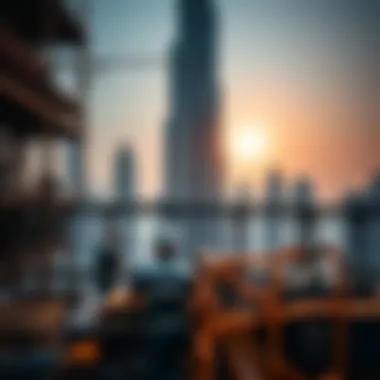
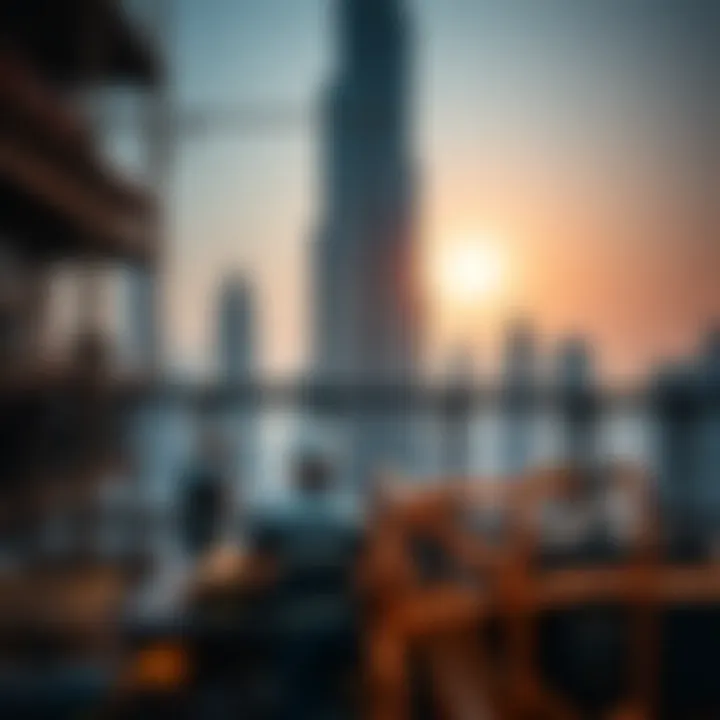
Weather and Environment
Dubai’s climate posed unique challenges for the Burj Khalifa project. With summers that can scorch at temperatures above 50 degrees Celsius, working conditions for construction crews were less than ideal. It wasn’t uncommon for temperature fluctuations to impact material integrity. On hot days, concrete set more quickly, which could lead to stress fractures if not managed properly.
Additionally, dust storms became a regular occurrence. These storms brought severe visibility issues that could halt work and delay progress. The design team had to consider how these environmental factors would affect construction timelines and outcomes. Flexible scheduling and robust contingency plans were essential. It wasn’t just about building up; it was about battling nature at every turn.
Some key strategies included:
- Material Selection: Using high-performance concrete that could withstand extreme temperatures.
- Work Hours Adjustments: Shifting construction hours to cooler parts of the day.
- Advanced Weather Tracking: Utilizing technology to monitor conditions and protect workers.
The skills of the architects and engineers were pushed to their limits, requiring an adaptive and calculated approach to manage the climate and sustain productivity on-site.
Safety Considerations
With any towering structure comes a plethora of safety considerations. Burj Khalifa's ambitious height demanded exceptionally rigorous safety protocols. Safety measures were a top priority, not just for compliance, but also for the well-being of the thousands involved in the construction process.
Every aspect of construction needed scrutiny. The team implemented comprehensive training programs for workers to navigate complex safety protocols that were unique to high-rise construction. This included mandatory safety gear, fall arrest systems, and regular drills to prepare for emergencies. The challenge lay in creating a routine where workers were vigilant but not hindered in their productivity.
On-site medical facilities provided instant access to healthcare in case of incidents, reflecting a deeper commitment to safety. Regular audits and inspections helped maintain high safety standards at every level of construction. Notable safety features included:
- Sturdy Scaffolding: Designed to support workers and materials safely at great heights.
- Safety Harnesses: Required for all workers at elevations above 2,000 meters.
- Emergency Protocols: Well-defined evacuation plans for unexpected incidents.
Adrian Smith’s vision was not just to create a landmark, but also a safe working environment where every crew member felt secure. The approaches taken during the challenging construction phases have set important precedents for future skyscraper projects in the region and beyond.
“Safety must always come first; after all, a building cannot rise without its builders on solid ground.”
Cultural Significance
The Burj Khalifa is not merely a feat of engineering; it serves as a beacon of cultural identity for Dubai and the broader Middle East. Symbolizing ambition and progress, it demonstrates how innovative architecture can encapsulate the aspirations of a nation. Its towering presence, stretching skyward, has redefined the skyline of Dubai, instilling national pride and global recognition.
Symbol of Modern Dubai
The Burj Khalifa stands tall as a monument to modernity and the evolution of urban life. It represents Dubai's fast-paced growth and transformation from a modest trading port into a bustling metropolis. The building transcends mere structure; it embodies values of resilience and ambition. An architectural masterpiece, it celebrates human ingenuity and innovation in the face of challenges.
"Sometimes, the tallest buildings hinge on the strength of the dreams that built them."
Adrian Smith, architect of the Burj Khalifa.
Further, the Burj Khalifa fosters a sense of unity within the diverse cultures that populate Dubai. This architectural marvel attracts visitors from all over the world, contributing to a cosmopolitan vibrancy that is uniquely Dubai. Locals and tourists alike find common ground beneath its shadow, sharing stories and experiences that marry tradition with modernity.
Tourism and Identity
Tourism serves as a lifeblood for Dubai’s economy, and the Burj Khalifa is undeniably its crown jewel. This skyscraper has seamlessly woven itself into the tourist fabric of the city, drawing millions of visitors eager to ascend its heights and experience unparalleled views. It plays a pivotal role in crafting Dubai's identity as a global tourist destination, effectively branding the city on an international scale.
The iconic status of Burj Khalifa has also prompted the development of various hospitality and entertainment sectors around it. Visitors flock to nearby attractions like the Dubai Fountain and the Dubai Mall, proving that the Burj Khalifa's influence extends well beyond its impressive facade. The impact on tourism is not incidental; rather, it’s a strategic triumph that enhances Dubai’s standing as a forward-thinking, innovative locale.
In essence, the cultural significance of the Burj Khalifa lies in its embodiment of Dubai's collective ambition, its ability to unite diverse cultures, and its instrumental role in promoting tourism. The skyscraper represents more than just a physical structure; it’s a story of hope, resilience, and a future that channels the spirit of the modern age.
Impact on Real Estate Market
The Burj Khalifa, standing tall at 828 meters, is not just a monumental achievement in architecture and engineering; it's also a catalyst for substantial shifts in the real estate market within Dubai and even beyond. The edifice's grand stature and iconic design have transformed perceptions, sparking both domestic and international investments. Understanding the impact on real estate market due to this skyscraper is essential for investors, realtors, and developers looking to explore opportunities spawned by this architectural marvel.
Influence on Property Values
When Burj Khalifa made its debut in 2010, it didn't just reshape the skyline; it also had a profound influence on local property values. The areas surrounding the skyscraper experienced an increase in desirability, leading to an upward trend in real estate prices.
Factors contributing to this surge in property values include:
- Proximity to Prestige: Living near the tallest building in the world automatically adds a layer of prestige to properties. Buyers are often willing to pay a premium to be associated with such an iconic landmark.
- Commercial Appeal: Development of mixed-use properties around the Khalifa has created vibrant commercial zones, drawing businesses and residents alike. This influx raises demand for housing and commercial spaces, pushing prices higher.
- Enhanced Infrastructure: The construction of the Burj Khalifa was accompanied by significant improvements to local infrastructure, including transportation links, and amenities, making the area more attractive. Advances such as the Dubai Metro have connected communities, further bolstering property values.
This phenomenon is not unique to Dubai; cities around the world have seen similar trends after the construction of iconic structures. Investing in real estate near landmark buildings often guarantees a potential increase in property value, and Burj Khalifa stands as a prime example of this reality.
Investment Opportunities
Beyond influencing property values, Burj Khalifa has opened a myriad of investment opportunities. Developers, investors, and even expatriates keen on diving into Dubai's real estate scene have found multiple avenues to explore stemming from the iconic building.
Consider the following avenues for investment:
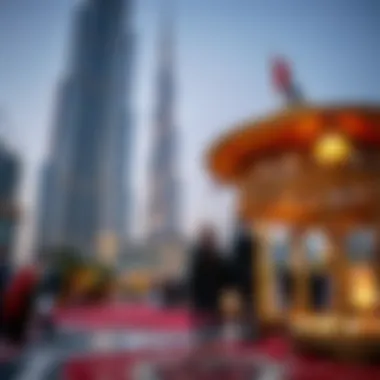
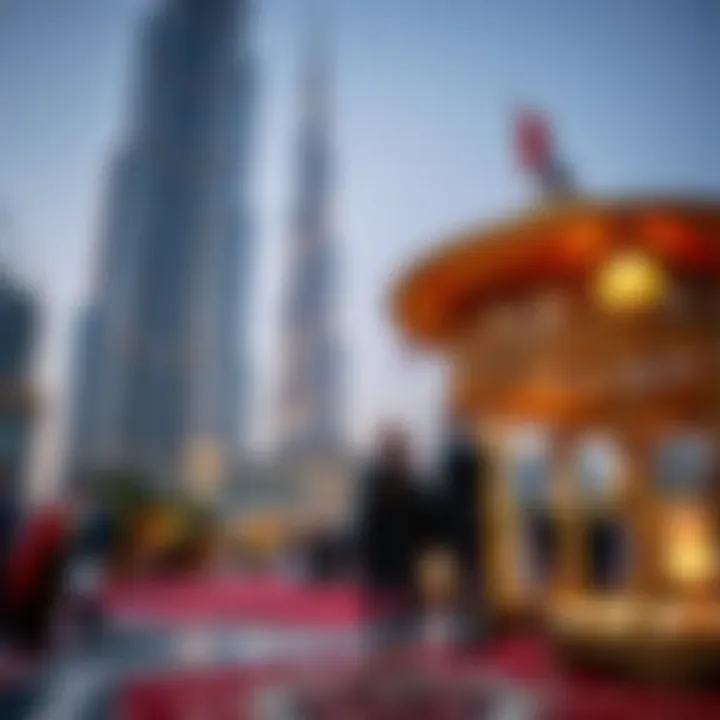
- Commercial Developments: Retail and office spaces in the vicinity of the Burj Khalifa are enticing for potential business ventures. With such a heavy footfall, it’s no wonder that real estate prices for commercial spaces have soared. Investors can capitalize on this by purchasing or leasing retail outlets to cater to tourists and locals alike.
- Luxury Residential Units: The demand for luxury housing within close proximity to the Burj Khalifa has seen a rise. High-end apartments and luxury condominiums have gained popularity among expatriates and wealthy investors seeking premium investment spots.
- Tourism-Driven Initiatives: The Burj Khalifa attracts millions of visitors each year, leading to opportunities in hospitality and related sectors. Developers can invest in hotels or short-term rental properties, leveraging the continuous influx of tourists.
Investing in real estate around Burj Khalifa isn't merely about owning property; it's about securing a stake in a thriving urban ecosystem that continues to evolve.
While opportunities are abundant, potential investors must conduct thorough research and have a keen eye on market trends. The economic landscape is shifting, and positioning oneself to catch the 'next wave' of real estate growth is critical. As Burj Khalifa continues to shape Dubai's skyline, its influence on the real estate market will likely persist, making it a noteworthy consideration for any investor looking to make their mark.
Sustainability Initiatives
Sustainability is not merely a trend in architecture; it is an essential principle guiding modern construction projects. The design and development of Burj Khalifa exemplify how towering structures can harmonize with an array of environmental considerations. This skyscraper has taken considerable strides towards being an eco-conscious edifice, showcasing that even the most ambitious architectural feats can align with sustainability goals.
Key elements of sustainability in Burj Khalifa include water conservation, energy savings, and a commitment to minimal environmental impact during both construction and operation. Each of these elements plays a crucial role in ensuring that this architectural marvel is not just a superficial emblem of luxury but a conscientious contributor to Dubai’s urban landscape.
Eco-Friendly Features
The Burj Khalifa incorporates numerous eco-friendly features that set benchmarks for future skyscrapers. One standout characteristic is its specialized irrigation system, which ensures the surrounding landscaping employs recycled water. Additionally, its unique building shape minimizes wind loads and maximizes natural ventilation, further reducing energy needs.
Among the prominent eco-friendly elements are:
- High-performance glass: The building uses double-glazed glass that reduces heat absorption, thus lowering cooling demands.
- Wind turbines and solar panels: Though not visible, the plans include provisions for future installations to harness renewable energy sources more efficiently.
- Green terraces: These areas not only beautify the building but also add layers of insulation, reducing reliance on heating and cooling systems.
These features showcase how Burj Khalifa does more than just scrape the sky; it aims to harmonize with essential ecological principles.
Energy Efficiency Measures
The Burj Khalifa boasts an array of energy efficiency measures that ensure the skyscraper operates within sustainable parameters while providing comfort to its inhabitants. By prioritizing energy efficiency, the building not only cuts long-term operational costs but also lessens its carbon footprint significantly.
A few notable energy efficiency measures employed include:
- Smart building technology: This system constantly monitors and adjusts lighting, heating, and air conditioning based on real-time occupancy needs.
- Energy-efficient plumbing fixtures: Low-flow toilets and faucets minimize water usage without sacrificing performance.
- Advanced LED lighting: The building utilizes LED technology throughout, drastically reducing electricity needs compared to traditional lighting systems.
These meticulous strategies align the Burj Khalifa with the aspirations of a future that value sustainable living, demonstrating that architectural ambition can go hand in hand with environmental responsibility.
"The Burj Khalifa isn't just an architectural wonder; it's a promise of what can be achieved when innovation meets sustainability."
With sustainability initiatives at the forefront of the Burj Khalifa’s design, the project embodies a model for future skyscrapers, challenging the industry to think beyond mere height and grandeur, promoting an eco-conscious approach that respects both people and the planet.
Future of Skyscrapers
The future of skyscrapers is not just about reaching new heights; it’s about reimagining urban spaces in ways that harmonize with the environment and enhance our quality of life. As cities grow taller and more densely populated, architects and developers face a unique set of challenges and opportunities. This topic is pivotal in understanding how innovations in material science, structural engineering, and sustainable technologies can influence not just building aesthetics but also functionality and livability.
Consider the importance of mixed-use buildings, where spaces for living, working, and recreation overlap. The Burj Khalifa exemplifies this idea. Its design allows for a blend of residential, commercial, and leisure activities, setting a precedent for future constructions. With an increasing focus on urban living, skyscrapers of tomorrow must prioritize this integration, and adapt to the practical needs of their inhabitants.
Trends in Architectural Design
In the world of skyscrapers, trends change like the blink of an eye, oftentimes dictated by technology and societal needs. Here are several key trends shaping the architectural landscape:
- Sustainability: There’s a noticeable shift toward buildings that reduce energy consumption and utilize renewable resources. Architects are incorporating solar panels, rainwater harvesting systems, and green roofs into designs.
- Adaptive Reuse: True to the old saying, "if it ain't broke, don't fix it," many cities are repurposing existing structures to meet modern demands. This trend reflects resourcefulness, as it often results in cost savings and preservation of history.
- Smart Buildings: With technology advancing at a lightning pace, skyscrapers are becoming smarter. Integrating IoT devices helps manage everything from energy usage to security systems, making structures more efficient and responsive to their environments.
- Vertical Greenery: Urban jungles are not just confined to the ground. By introducing vertical gardens or living walls, skyscrapers can enhance biodiversity, improve air quality, and provide recreational spaces.
These trends show how architects are not merely focused on aesthetics but are also considering the community's needs, leading to spaces that foster relationships and environments that nurture well-being.
Lessons from Burj Khalifa
Burj Khalifa has served not only as a marvel of engineering but also as a case study for future architectural projects. Several lessons can be gleaned from its design and execution:
- Collaboration is Key: The project team behind Burj Khalifa included designers, engineers, and contractors from various backgrounds, highlighting the importance of collaboration in tackling complex design challenges.
- Adaptability in Design: The construction process faced numerous hurdles, from soil issues to fluctuating weather conditions. How these challenges were addressed stands as a testament to the necessity of flexibility in architectural planning.
- Cultural Context Matters: A skyscraper's design must not only reflect modernity but also resonate with local culture. The Burj Khalifa draws inspiration from Islamic architecture, making it an integral part of Dubai’s skyline.
- Focus on User Experience: While soaring heights are appealing, ensuring the comfort and experience of those who use the space is paramount. Consideration of how individuals interact with the building informs design decisions.
- Sustainability and Efficiency: The efficient use of water and energy resources throughout the Burj's design is a critical lesson for future projects. Emphasizing sustainability is no longer optional but essential for the longevity of buildings and planet alike.
By applying these lessons, future architectural designs can create more than structures; they can build environments that truly enrich human life while respecting our Earth.
Ending
Enduring Legacy
The legacy of Burj Khalifa transcends its height; it has become an integral part of Dubai's identity. The building is a testament to what can be achieved when vision and execution align. From attracting millions of tourists to inspiring modern architecture, it lays groundwork for future innovators in the field. The striking silhouette against the Dubai skyline serves not only as a beacon of modernity but also as a reminder that perseverance and creativity can push boundaries. Its impact can be seen in a plethora of skyscrapers constructed post its completion, often attempting to echo its grandeur and ambition.
Continuing Influence
As the architectural landscape evolves, the influence of Burj Khalifa persists. Its design principles and construction methodologies are studied in architecture schools worldwide. The building sets new standards for skyscraper design, particularly in relation to sustainability and cutting-edge technology. Looking further, real estate developers and city planners take cues from its success, integrating similar bold designs into urban plans. This speaks to the project’s dual role as an artistic endeavor and a commercial venture—an embodiment of how visionary architecture can morph the economic and cultural fabric of a city.
"Burj Khalifa is not just a piece of infrastructure; it is an assertion of human potential, a pioneering statement that joins form and function seamlessly."
As we continue to gaze up at this architectural marvel, we acknowledge that its legacy and influence will likely resonate across generations, energizing future architects and developers to dream bigger and reach higher.















